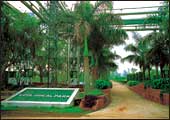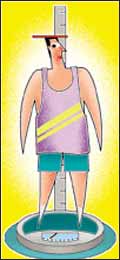|
|
|
Green's new champions:
For once, big business was on the right side of the effort
to save threatened bird species
|
|
|
I
can see the refinery's gas-flare while we are still 10 kilometres
away from Mathura. This is no ordinary refinery. The Indian Oil
Corporation's 8.8 million metric tonnes a year refinery at Mathura,
one hour from Agra, and located in the sensitive Taj Trapezium Zone
on National Highway 2 processes low sulphur crude oils from Bombay
High and Nigeria and high sulphur crude from West Asia. Oil refineries
bring out the worst in green activists. This one has been accused
of having played a large part in effecting a change in the colour
of the Taj-from milky white to yellowish-white. But it isn't the
refinery, or the Taj, or its colour I am interested in-it is in
the much-studied concept of migration.
The Book of Jeremiah has a line that says "The
stork in the heavens knoweth her appointed time; and the turtledove,
and the crane, and the swallow, observe the time of their coming".
And the flight of quail that saved the Israelites from starvation
during their march through the Sinai is now accepted to be a fallout
of the mass migration of birds from their breeding grounds in eastern
Europe and Western Asia, and their winter home in Africa. The trip
to Mathura has everything to do with migration and little to do
with religion, although the city encompasses all of ancient day
Brindavan, where the Hindu God Krishna once frolicked.
| How The Refinery Went
Eco-Friendly...
» By
providing unleaded petrol to Delhi since March 1995...
» By supplying
low sulphur diesel in the Taj Trapezium area since July 1996...
» .By making
low-sulphur petrol since July 1998...
» By switching
entirely to low sulphur diesel since August 1999.
...And Helped These Migratory Birds
Bar Headed Goose (Anser indicus)
Pintail (Anas acuta)
Common Teal (Anas crecca)
Mallard (Anas platyrhynchos)
Gadwall (Anas Strepera )
Wigeon (Anas penelope)
Garganey (Anas querquedula)
Northern Shoveller (Anas clypeata)
Red crested pochard (Netta rufina)
White eyed pochard (Aythya nyroca)
Tufted pochard (Aythya fuligula)
Common sandpiper (Tringa hypoleucos)
Yellow Wagtail (Motacilla flava)
Yellowheaded Wagtail (Motacilla citreola)
Grey Wagtail (Motacilla cinerea)
White wagtail (Motacilla alba)
|
Not too long ago, I would have had to travel
a further 100 kilometres by road to experience the phenomenon of
migration first-hand. Keoladeo National Park, popularly referred
to as Bharatpur Bird Sanctuary is a world heritage site and usually
the destination of thousands of migratory birds. But birds need
water and Keoladeo is reeling under the effects of a drought that
has hit the state of Rajasthan.
At least some of the birds have found an alternate
home-the five 1,800 square metre polishing ponds attached to the
effluent treatment plant at the Mathura refinery. The ponds are
located in the 18,000 square metre ecological park at the refinery-a
park where the Bombay Natural History Society has recorded a total
of 96 winged species, including 30 migratory ones. I'm not favourably
inclined to oil companies but have to admit that the park is g-r-e-e-n;
and the presence of the birds, and their nests in the polishing
ponds clearly reflects the low level of pollution at the refinery.
There are northern shovellers, pintails, tufted pochards (all migratory
species), and resident waterfowl, spot billed ducks, herons, ibises,
egrets, and painted stork. The local birds have been around ever
since the ecological park came up in 1993, but the migratory species
are recent additions, a consequence of the drying up of Bharatpur.
''The ecological park at the Mathura refinery can rival any bird
sanctuary in India,'' gloats M.S. Ramachandran, the Chairman and
MD of IOC. He then proceeds to rattle off the environmental certifications
and awards collected by it: the ISO 14001 and the Golden Tech Environment
Excellence Award in 2000, 2001, and 2003.
|
|
|
Safe haven: The park
at Mathura refinery has proved a major boon for the migratory
birds
|
 |
| The ecological Park at the Mathura
refinery : Sanctuary! |
At the core of the avian-friendly ambience of
the Mathura refinery is an 'eeteepee' as employees term it, a modern
effluent treatment plant (ETP). This works on three levels: physical,
to separate oil and water; chemical, to remove sulphides; and biological
to facilitate biodegradation of organics, the removal of settleable
solids, and natural aeration. The polishing pools, for those who'd
like to know their eeteepees, form the last stage in the effluent
treatment where the water surges from an underground pipe of one
metre through tiled flooring. The pond is divided into five parallel
channels by means of bunds. All the five bunds are kept in series
and an average depth of 1.5 metre is maintained. Here the water
is subjected to sedimentation in a clarifier where by natural aeration
and symbiosis of underwater plants and micro-organisms. The major
chunk of the treated effluent is recycled for various uses in the
refinery resulting in conservation of fresh water. The remaining
part is let in the river Yamuna and the Barari minor canal. That
description may sound like gibberish to some, but to avid natural
historians it is as sweet a birdsong as they're likely to hear in
India. Says Asad R. Rahmani, Director, BNHS: ''It was a wonderful
experience to see nearly 3,000 waterfowl in the safe havens of the
ecological park.''
As I leave the refinery, I remember that an
acquaintance and fellow hobby-naturalist had once narrated a similar
story-of the Chennai-based Amalgamations Group's sprawling manufacturing
facilities at Sembiyam on the outskirts of the city serving as a
nesting ground to birds, both resident and migratory, that couldn't
find a clean patch of green or water anywhere else. I wonder, do
these birds, here and in Chennai know that they have big business
to thank?
|
TREADMILL
|
| Looser Pants=Better Health
 What's
your BMI?" I asked an acquaintance recently and she looked
indignantly at me as though I'd committed an impropriety.
We were talking about fitness and exchanging notes about our
respective gyms when I casually asked her the B question.
And got the said response. It took me a few seconds to realise
that she didn't know what I was talking about. Indeed, many
of my fellow gym-goers, who assiduously line up at the gym's
industrial contraption that passes off as the weighing machine,
have remarked that they didn't know what their BMI was. Or
rather what BMI is. So here's a quickie on BMI. What's
your BMI?" I asked an acquaintance recently and she looked
indignantly at me as though I'd committed an impropriety.
We were talking about fitness and exchanging notes about our
respective gyms when I casually asked her the B question.
And got the said response. It took me a few seconds to realise
that she didn't know what I was talking about. Indeed, many
of my fellow gym-goers, who assiduously line up at the gym's
industrial contraption that passes off as the weighing machine,
have remarked that they didn't know what their BMI was. Or
rather what BMI is. So here's a quickie on BMI.
BMI or body mass index is the ratio of your weight to your
height. And it has become the standard measure of whether
you're obese or not. BMI=Kg/m2. That is, your weight in kilograms,
divided by the square of your height in metres. A few years
back, a group of British researchers studied 7,700 men (aged
15-plus) and found that for the average male, the optimal
BMI for good health is 22. That would be a six-foot man weighing
72.5 kgs. That, dear reader, is a very lean man. The researchers
also found that men with higher BMIs experienced more health
ailments. And the same holds true for women. Here's what your
target BMI should be.
Underweight=Less than 18.5
Normal weight=18.5 - 24.9
Overweight=25 - 29.9
Obesity=BMI of 30 or greater
Yet there's a caveat. BMI can be misleading if you're packed
with lean muscle because muscle adds to your weight and hence
the numerator of the ratio becomes larger, yielding a higher
BMI. In fact, a serious body-builder (or even someone who
does regular weight training at least three times a week along
with a cardiovascular session thrown in each day), could be
healthy with a BMK of as high as 26. Still, even body-builders
whose BMI approaches 30 are at risk.
What's the risk? Plenty. A high BMI puts you at risk for
heart disease, diabetes, high blood pressure, gall bladder
disease, and even some forms of cancer. Scared? Check your
BMI now and take the remedial measures. And if your maths
is rusty, go to any one of these two sites to calculate your
BMI with a click of the mouse:
http://www.halls.md/body-mass-index/av.htm
http://www.phaster.com/unpretentious/bmi.html
And if your BMI is well beyond 25, I'm sure you know what
to do-exercise regularly and watch your diet.
-MUSCLES MANI
|
|

